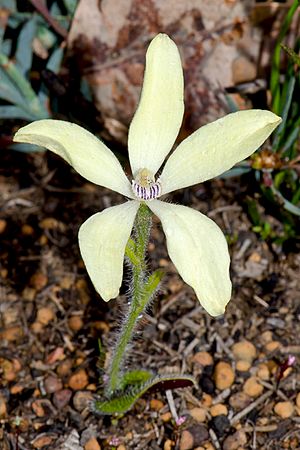White china orchid facts for kids
Quick facts for kids White china orchid |
|
|---|---|
 |
|
| Caladenia ixioides growing near Wundowie | |
| Scientific classification | |
| Genus: |
Caladenia
|
| Species: |
ixioides
|
| Synonyms | |
|
|
The white china orchid, also known as Caladenia ixioides, is a special type of plant in the orchid family. It grows only in the south-west part of Western Australia. This means it is endemic to that area.
This orchid has one flat, wide leaf. It also grows up to three pretty yellow or white flowers. You can mostly find these orchids in woodlands and forests near the city of Perth. For a while, this plant was known by a different name, Cyanicula ixioides.
Contents
What Does the White China Orchid Look Like?
The white china orchid is a perennial plant, which means it lives for more than two years. It's also a deciduous herb, so it loses its leaves at certain times of the year. This plant grows from a special underground part called a tuber, which is like a small storage root.
Each orchid has one flat leaf. This leaf is about 20 to 40 millimeters (0.8 to 1.6 inches) long. It is also about 15 to 20 millimeters (0.6 to 0.8 inches) wide. The underside of the leaf has a reddish-purple color.
Orchid Flowers
The white china orchid can grow up to three white or yellow flowers. These flowers are about 30 to 50 millimeters (1.2 to 2 inches) long and wide. They grow on a stalk that stands 40 to 150 millimeters (1.6 to 5.9 inches) tall.
The top part of the flower is called the dorsal sepal. It stands straight up and is about 20 to 25 millimeters (0.8 to 1 inch) long. The side sepals and petals are similar in size.
The special lip-like part of the flower is called the labellum. It is about 5 to 9 millimeters (0.2 to 0.4 inches) long. It is also about 3 to 5 millimeters (0.1 to 0.2 inches) wide. The labellum is usually pale yellow or white with purple stripes. Its sides have small, short teeth. The tip of the labellum curves downwards. Many tiny, bead-like bumps, called calli, cover the labellum.
These beautiful orchids usually bloom between September and October.
How the White China Orchid Got Its Name
The white china orchid was first officially described in 1840. A scientist named John Lindley wrote about it. His description was published in a book called A Sketch of the Vegetation of the Swan River Colony.
Later, in 2000, two other scientists, Stephen Hopper and Andrew Brown, changed its name to Cyanicula ixioides. But in 2015, after more studies, Mark Clements changed the name back to Caladenia ixioides.
The second part of its name, ixioides, comes from a plant called Ixia. Scientists thought this orchid looked similar to plants in the Ixia genus. The ending -oides means "likeness" in Latin. So, ixioides means "like Ixia".
Where the White China Orchid Lives
This type of Caladenia orchid is mostly found between the towns of York and Bindoon. These areas are part of the Avon Wheatbelt, Jarrah Forest, and Swan Coastal Plain biogeographic regions.
The white china orchid grows in forests and woodlands. It often grows under wandoo and jarrah trees.
Protecting the White China Orchid
The Western Australian Government's Department of Parks and Wildlife has looked at the white china orchid. They have classified it as "not threatened." This means it is not currently in danger of disappearing.

